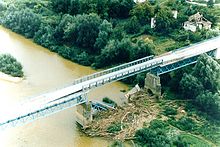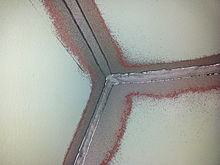
Bridge
Background Information
SOS believes education gives a better chance in life to children in the developing world too. Do you want to know about sponsoring? See www.sponsorachild.org.uk
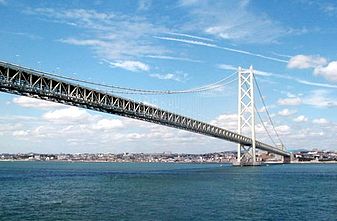
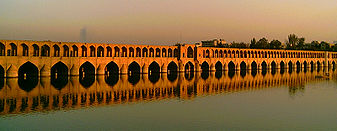
| Public infrastructure |
|---|
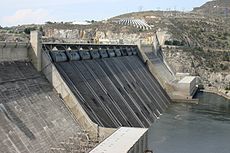 |
| Assets and facilities |
|
| Concepts |
|
| Issues and ideas |
|
| Fields of study |
|
|
Examples
|
| Infrastructure portal |
A bridge is a structure built to span physical obstacles such as a body of water, valley, or road, for the purpose of providing passage over the obstacle. There are many different designs that all serve unique purposes and apply to different situations. Designs of bridges vary depending on the function of the bridge, the nature of the terrain where the bridge is constructed, the material used to make it and the funds available to build it.
Etymology
The Oxford English Dictionary traces the origin of the word bridge to an Old English word brycg, of the same meaning, derived from the hypothetical Proto-Germanic root brugjō. There are cognates in other Germanic languages.
History
The first bridges were made by nature itself — as simple as a log fallen across a stream or stones in the river. The first bridges made by humans were probably spans of cut wooden logs or planks and eventually stones, using a simple support and crossbeam arrangement. Some early Americans used trees or bamboo poles to cross small caverns or wells to get from one place to another. A common form of lashing sticks, logs, and deciduous branches together involved the use of long reeds or other harvested fibers woven together to form a connective rope capable of binding and holding together the materials used in early bridges.

The Arkadiko Bridge is one of four Mycenaean corbel arch bridges part of a former network of roads, designed to accommodate chariots, between Tiryns to Epidauros in the Peloponnese, in Greece. Dating to the Greek Bronze Age (13th century BC), it is one of the oldest arch bridges still in existence and use. Several intact arched stone bridges from the Hellenistic era can be found in the Peloponnese in southern Greece
The greatest bridge builders of antiquity were the ancient Romans. The Romans built arch bridges and aqueducts that could stand in conditions that would damage or destroy earlier designs. Some stand today. An example is the Alcántara Bridge, built over the river Tagus, in Spain. The Romans also used cement, which reduced the variation of strength found in natural stone. One type of cement, called pozzolana, consisted of water, lime, sand, and volcanic rock. Brick and mortar bridges were built after the Roman era, as the technology for cement was lost then later rediscovered.
The Arthashastra of Kautilya mentions the construction of dams and bridges. A Mauryan bridge near Girnar was surveyed by James Princep. The bridge was swept away during a flood, and later repaired by Puspagupta, the chief architect of emperor Chandragupta I. The bridge also fell under the care of the Yavana Tushaspa, and the Satrap Rudra Daman. The use of stronger bridges using plaited bamboo and iron chain was visible in India by about the 4th century. A number of bridges, both for military and commercial purposes, were constructed by the Mughal administration in India.
Although large Chinese bridges of wooden construction existed at the time of the Warring States, the oldest surviving stone bridge in China is the Zhaozhou Bridge, built from 595 to 605 AD during the Sui Dynasty. This bridge is also historically significant as it is the world's oldest open- spandrel stone segmental arch bridge. European segmental arch bridges date back to at least the Alconétar Bridge (approximately 2nd century AD), while the enormous Roman era Trajan's Bridge (105 AD) featured open-spandrel segmental arches in wooden construction.
Rope bridges, a simple type of suspension bridge, were used by the Inca civilization in the Andes mountains of South America, just prior to European colonization in the 16th century.
During the 18th century there were many innovations in the design of timber bridges by Hans Ulrich, Johannes Grubenmann, and others. The first book on bridge engineering was written by Hubert Gautier in 1716. A major breakthrough in bridge technology came with the erection of the Iron Bridge in Coalbrookdale, England in 1779. It used cast iron for the first time as arches to cross the river Severn.
With the Industrial Revolution in the 19th century, truss systems of wrought iron were developed for larger bridges, but iron did not have the tensile strength to support large loads. With the advent of steel, which has a high tensile strength, much larger bridges were built, many using the ideas of Gustave Eiffel.
In 1927 welding pioneer Stefan Bryła designed the first welded road bridge in the world, which was later built across the river Słudwia Maurzyce near Łowicz, Poland in 1929. In 1995, the American Welding Society presented the Historic Welded Structure Award for the bridge to Poland.
Types of bridges
Bridges can be categorized in several different ways. Common categories include the type of structural elements used, by what they carry, whether they are fixed or movable, and by the materials used.
Structure type
Bridges may be classified by how the forces of tension, compression, bending, torsion and shear are distributed through their structure. Most bridges will employ all of the principal forces to some degree, but only a few will predominate. The separation of forces may be quite clear. In a suspension or cable-stayed span, the elements in tension are distinct in shape and placement. In other cases the forces may be distributed among a large number of members, as in a truss, or not clearly discernible to a casual observer as in a box beam.
Beam bridge  |
Beam bridges are horizontal beams supported at each end by substructure units and can be either simply supported when the beams only connect across a single span, or continuous when the beams are connected across two or more spans. When there are multiple spans, the intermediate supports are known as piers. The earliest beam bridges were simple logs that sat across streams and similar simple structures. In modern times, beam bridges can range from small, wooden beams to large, steel boxes. The vertical force on the bridge becomes a shear and flexural load on the beam which is transferred down its length to the substructures on either side They are typically made of steel, concrete or wood. Beam bridge spans rarely exceed 250 feet (76 m) long, as the flexural stresses increase proportional to the square of the length (and deflection increases proportional to the 4th power of the length). However, the main span of the Rio-Niteroi Bridge, a box girder bridge, is 300 metres (980 ft). The world's longest beam bridge is Lake Pontchartrain Causeway in southern Louisiana in the United States, at 23.83 miles (38.35 km), with individual spans of 56 feet (17 m). Beam bridges are the most common bridge type in use today. |
Truss bridge 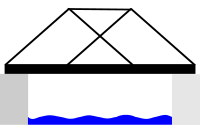 |
A truss bridge is a bridge whose load-bearing superstructure is composed of a truss. This truss is a structure of connected elements forming triangular units. The connected elements (typically straight) may be stressed from tension, compression, or sometimes both in response to dynamic loads. Truss bridges are one of the oldest types of modern bridges. The basic types of truss bridges shown in this article have simple designs which could be easily analyzed by nineteenth and early twentieth century engineers. A truss bridge is economical to construct owing to its efficient use of materials. |
Cantilever bridge 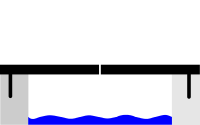 |
Cantilever bridges are built using cantilevers—horizontal beams supported on only one end. Most cantilever bridges use a pair of continuous spans that extend from opposite sides of the supporting piers to meet at the centre of the obstacle the bridge crosses. Cantilever bridges are constructed using much the same materials & techniques as beam bridges. The difference comes in the action of the forces through the bridge. The largest cantilever bridge is the 549-metre (1,801 ft) Quebec Bridge in Quebec, Canada. |
Arch bridge  |
Arch bridges have abutments at each end. The weight of the bridge is thrust into the abutments at either side. The earliest known arch bridges were built by the Greeks, and include the Arkadiko Bridge. With the span of 220 metres (720 ft), the Solkan Bridge over the Soča River at Solkan in Slovenia is the second largest stone bridge in the world and the longest railroad stone bridge. It was completed in 1905. Its arch, which was constructed from over 5,000 tonnes (4,900 long tons; 5,500 short tons) of stone blocks in just 18 days, is the second largest stone arch in the world, surpassed only by the Friedensbrücke (Syratalviadukt) in Plauen, and the largest railroad stone arch. The arch of the Friedensbrücke, which was built in the same year, has the span of 90 m (300 ft) and crosses the valley of the Syrabach River. The difference between the two is that the Solkan Bridge was built from stone blocks, whereas the Friedensbrücke was built from a mixture of crushed stone and cement mortar. The world's current largest arch bridge is the Chaotianmen Bridge over the Yangtze River with a length of 1,741 m (5,712 ft) and a span of 552 metres (1,811 ft). The bridge was open April 29, 2009 in Chongqing, China. |
Tied arch bridge 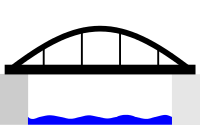 |
Tied arch bridges have an arch-shaped superstructure, but differ from conventional arch bridges. Instead of transferring the weight of the bridge and traffic loads into thrust forces into the abutments, the ends of the arches are restrained by tension in the bottom chord of the structure. They are also called bowstring arches. |
Suspension bridge 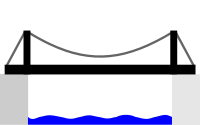 |
Suspension bridges are suspended from cables. The earliest suspension bridges were made of ropes or vines covered with pieces of bamboo. In modern bridges, the cables hang from towers that are attached to caissons or cofferdams. The caissons or cofferdams are implanted deep into the floor of a lake or river. Sub-types include the simple suspension bridge, the stressed ribbon bridge, the underspanned suspension bridge, the suspended-deck suspension bridge, and the self-anchored suspension bridge. The longest suspension bridge in the world is the 3,909 m (12,825 ft) Akashi Kaikyo Bridge in Japan. |
Cable-stayed bridge  |
Cable-stayed bridges, like suspension bridges, are held up by cables. However, in a cable-stayed bridge, less cable is required and the towers holding the cables are proportionately shorter. The first known cable-stayed bridge was designed in 1784 by C.T. Loescher. The longest cable-stayed bridge is the Sutong Bridge over the Yangtze River in China. |
Fixed or movable bridges
Most bridges are fixed bridges, meaning they have no moving parts and stay in one place until they fail or are demolished. Temporary bridges, such as Bailey bridges, are designed to be assembled, and taken apart, transported to a different site, and re-used. They are important in military engineering, and are also used to carry traffic while an old bridge is being rebuilt. Movable bridges are designed to move out of the way of boats or other kinds of traffic, which would otherwise be too tall to fit. These are generally electrically powered.
Double-decked bridges
Double-decked or double-decker bridges have two levels, such as the San Francisco – Oakland Bay Bridge, with two road levels. Tsing Ma Bridge and Kap Shui Mun Bridge in Hong Kong have six lanes on their upper decks, and on their lower decks there are two lanes and a pair of tracks for MTR metro trains. Some double-decker bridges only use one level for street traffic; the Washington Avenue Bridge in Minneapolis reserves its lower level for automobile traffic and its upper level for pedestrian and bicycle traffic (predominantly students at the University of Minnesota). Likewise, in Toronto, the Prince Edward Viaduct has five lanes of motor traffic, bicycle lanes, and sidewalks on its upper deck; and a pair of tracks for the Bloor–Danforth subway line on its lower deck.
Robert Stephenson's High Level Bridge across the River Tyne in Newcastle upon Tyne, completed in 1849, is an early example of a double-deck bridge. The upper level carries a railway, and the lower level is used for road traffic. Other examples include Britannia Bridge over the Menai Strait and Craigavon Bridge in Derry, Northern Ireland. The Oresund Bridge between Copenhagen and Malmö consists of a four-lane highway on the upper level and a pair of railway tracks at the lower level. The George Washington Bridge between New Jersey and New York has two roadway levels. It was built with only the upper roadway as traffic demands did not require more capacity. A truss work between the roadway levels provides stiffness to the roadways and reduced movement of the upper level when installed. The George Washington bridge is also the most used bridge in the world. Tower Bridge is different example of a double-decker bridge, with the central section consisting of a low level bascule span and a high level footbridge.
Viaducts
A viaduct is made up of multiple bridges connected into one longer structure. The longest and some of the highest bridges are viaducts, such as the Lake Pontchartrain Causeway and Millau Viaduct.
Bridge types by use
A bridge can be categorized by what it is designed to carry, such as trains, pedestrian or road traffic, a pipeline or waterway for water transport or barge traffic. An aqueduct is a bridge that carries water, resembling a viaduct, which is a bridge that connects points of equal height. A road-rail bridge carries both road and rail traffic. A bridge can carry overhead power lines as does the Storstrøm Bridge.
Some bridges accommodate other purposes, such as the tower of Nový Most Bridge in Bratislava, which features a restaurant, or a bridge-restaurant which is a bridge built to serve as a restaurant. Other suspension bridge towers carry transmission antennas.
Bridges are subject to unplanned uses as well. The areas underneath some bridges have become makeshift shelters and homes to homeless people, and the undersides of bridges all around the world are spots of prevalent graffiti. Some bridges attract people attempting suicide, and become known as suicide bridges.
Bridge types by material
The materials used to build the structure are also used to categorize bridges. Until the end of the 18th Century, bridges were made out of timber, stone and masonry. Modern bridges are currently built in concrete, steel, fibre reinforced polymers (FRP), stainless steel or combinations of those materials.
The Iron Bridge completed in 1779 was the first cast iron bridge.
Aesthetics
Most bridges are utiltiarian in appearance, but in some cases, the appearance of the bridge can have great importance. Often, this is the case with a large bridge that serves as an entrance to a city, or crosses over a main harbour entrance. These are sometimes known as signature bridges. Designers of bridges in parks and along parkways often place more importance to aesthetics, as well. Examples include the stone-faced bridges along the Taconic State Parkway in New York.
To create a beautiful image, some bridges are built much taller than necessary. This type, often found in east-Asian style gardens, is called a Moon bridge, evoking a rising full moon. Other garden bridges may cross only a dry bed of stream washed pebbles, intended only to convey an impression of a stream. Often in palaces a bridge will be built over an artificial waterway as symbolic of a passage to an important place or state of mind. A set of five bridges cross a sinuous waterway in an important courtyard of the Forbidden City in Beijing, China. The central bridge was reserved exclusively for the use of the Emperor, Empress, and their attendants.
Bridge maintenance
Bridge maintenance consisting of a combination of structural health monitoring and testing. This is regulated in country-specific engineer standards and includes e.g. an ongoing monitoring every three to six months, a simple test or inspection every two to three years and a major inspection every six to ten years. In Europe, the cost of maintenance is higher than spending on new bridges. The lifetime of welded steel bridges can be significantly extended by aftertreatment of the weld transitions . This results in a potential high benefit, using existing bridges far beyond the planned lifetime.
Bridge failures
The failure of bridges is of special concern for structural engineers in trying to learn lessons vital to bridge design, construction and maintenance. The failure of bridges first assumed national interest during the Victorian era when many new designs were being built, often using new materials.
In the United States, the National Bridge Inventory tracks the structural evaluations of all bridges, including designations such as "structurally deficient" and "functionally obsolete".
Bridge monitoring
There are several methods used to monitor the stress on large structures like bridges. The most common method is the use of an accelerometer, which is integrated into the bridge while it is being built. This technology is used for long-term surveillance of the bridge.
Another option for structural-integrity monitoring is "non-contact monitoring", which uses the Doppler effect (Doppler shift). A laser beam from a Laser Doppler Vibrometer is directed at the point of interest, and the vibration amplitude and frequency are extracted from the Doppler shift of the laser beam frequency due to the motion of the surface. The advantage of this method is that the setup time for the equipment is faster and, unlike an accelerometer, this makes measurements possible on multiple structures in as short a time as possible. Additionally, this method can measure specific points on a bridge that might be difficult to access.

